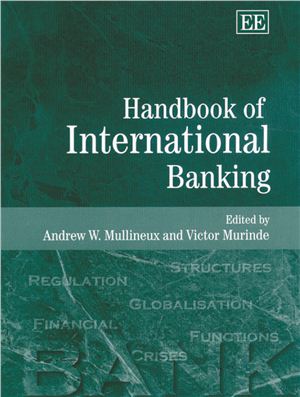Author: Andrew W. Mullineux.
Paperback: 832 pages.
Publisher: Edward Elgar Publishing (April 2003).
Language: English.
ISBN: 1840640936.
The Handbook of Inteational Banking provides a clearly accessible source of reference material, covering the main developments that reveal how the inteationalization and globalization of banking have developed over recent decades to the present, and to analyze the creation of a new global financial architecture.
The Handbook is the first of its kind in the area of inteational banking with contributions from leading specialists in their respective fields, often with remarkable experience in academia or professional practice. The material is provided mainly in the form of self-contained surveys, which trace the main developments in a well-defined topic, together with specific references to joual articles and working papers. Some contributions, however, aim to disseminate new empirical findings especially where competing paradigms are evaluated.
The Handbook is divided into four areas of interest. The first deals with the globalization of banking and continues on to banking structures and functions. The authors then focus on banking risks, crises and regulation and finally the evolving inteational financial architecture.
Designed to serve as a source of supplementary reading and inspiration, the Handbook is suited to a range of courses in banking and finance including post-experience and in-house programs for bankers and other financial services practitioners. This outstanding volume will become essential reference for policymakers, financial practitioners as well as academics and researchers in the field.
Paperback: 832 pages.
Publisher: Edward Elgar Publishing (April 2003).
Language: English.
ISBN: 1840640936.
The Handbook of Inteational Banking provides a clearly accessible source of reference material, covering the main developments that reveal how the inteationalization and globalization of banking have developed over recent decades to the present, and to analyze the creation of a new global financial architecture.
The Handbook is the first of its kind in the area of inteational banking with contributions from leading specialists in their respective fields, often with remarkable experience in academia or professional practice. The material is provided mainly in the form of self-contained surveys, which trace the main developments in a well-defined topic, together with specific references to joual articles and working papers. Some contributions, however, aim to disseminate new empirical findings especially where competing paradigms are evaluated.
The Handbook is divided into four areas of interest. The first deals with the globalization of banking and continues on to banking structures and functions. The authors then focus on banking risks, crises and regulation and finally the evolving inteational financial architecture.
Designed to serve as a source of supplementary reading and inspiration, the Handbook is suited to a range of courses in banking and finance including post-experience and in-house programs for bankers and other financial services practitioners. This outstanding volume will become essential reference for policymakers, financial practitioners as well as academics and researchers in the field.

